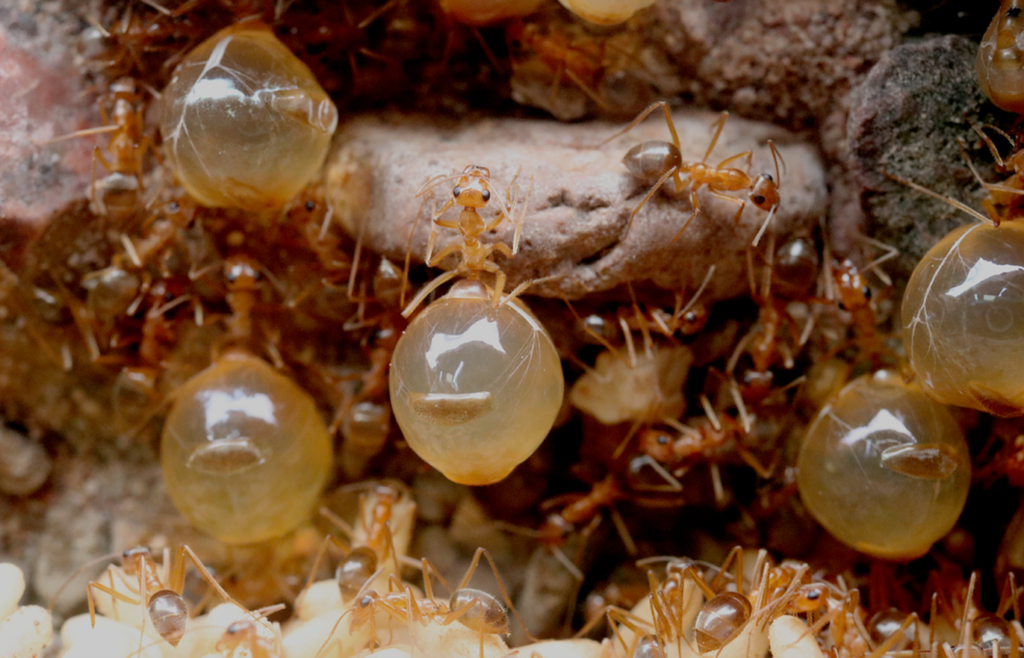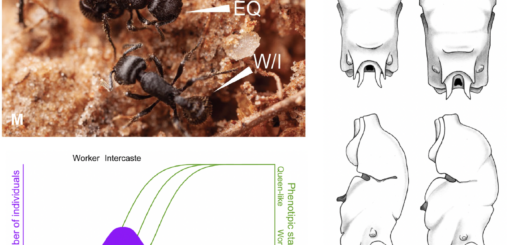Shedding light on the evolutionary origins of repletism in ants
In the recent paper “The first fossil replete ant worker establishes living food storage in the Eocene” published in Myrmecological News, Sawh et al.* focus on the specialization of worker ants and the evolution of a particular trait called “repletism”, which involves the storage of liquid food by certain workers in some ant species. The researchers discovered the first fossil evidence of repletism in a now-extinct ant species called Leptomyrmex neotropicus, which was preserved in Miocene-age Dominican amber. They also found evidence of repletism in a living species closely related to L. neotropicus. By analyzing the findings, the researchers reconstructed the evolutionary history of repletism and determined that Leptomyrmex likely acquired this trait in the Eocene period, making it the earliest known example of “honeypot” ants among all ants, both living and extinct. Here, Gabriela Camacho highlights the main points of the study.
* = Indira Sawh, Eunice Bae, Luciana Camilo, Michele Lanan, Andrea Lucky, Henrique Morais Menezes, Gianpiero Fiorentino, Christine Sosiak, Lily Khadempour and Phillip Barden.
A View by Gabriela Procopio Camacho

Eusociality, a remarkable phenomenon found in various insect species, and characteristic of all ants, has captivated researchers for decades. This unique social system depends on and influences the behavior and morphology of individuals within a colony, giving rise to specialized castes with distinct roles and functions. One intriguing aspect of ant caste specialization is “repletism”, a fascinating adaptation where certain workers serve as living food storage units. Repletes, known as honeypot ants in certain species, possess distended crops that allow them to store and redistribute liquid food to other members of the colony through a process known as trophallaxis (i.e., exchange of liquids between, for example, workers or from workers to brood).
Repletism has been observed in various ant lineages, with approximately 20 genera documented to have scattered species with replete castes. However, in genera like Myrmecocystus, Leptomyrmex and Pheidole, most or all species have documented repletes. These specialized workers can be classified into two main types: crop repletes and fat body repletes. Crop repletes store liquid carbohydrates, like those of genus Myrmecocystus, while fat body repletes contain hypertrophied fat bodies rich in lipids, as reported for Prenolepis impairs (Say, 1836). Both types of repletes play vital roles in a colony’s nutrient storage and provisioning during periods of resource scarcity. Repletism carries significant ecological implications for ant colonies. The ability to store and redistribute food resources through trophallaxis, facilitated by replete workers, ensures a reliable source of high-quality food for the entire colony. During periods of resource scarcity, repletes act as living reservoirs, helping sustain the colony’s survival. Understanding the evolutionary origins of repletism can provide crucial insights into the development of this remarkable adaptation and its ecological significance.
While replete workers have been identified in several ant species, they are usually present in the subfamilies Formicinae and Myrmicinae. The only exception occurs in the gneus Leptomyrmex, a dolichoderine genus with a remarkable biogeographical history. Although fairly diverse in Australia, New Guinea, and New Caledonia, these ants were thought to be endemic to the Australasian region, and their presence in the Neotropics remained unknown until recent discoveries of a fossil species in Dominican amber and an extant species in the Brazilian Cerrado. Similarly, although replete workers are well documented for the Australasian species, there were no records for this trait for the Neotropical species. Utilizing advanced imaging techniques such as microCT, Sawh and colleagues were able to confirm the replete status of the extinct Caribbean species, Leptomyrmex neotropicus, and identify replete workers in the extant Brazilian species, Leptomyrmex relictus.

To further unravel the evolutionary history of repletism in Leptomyrmex, the authors employed ancestral state reconstruction techniques. By analyzing natural history data obtained from L. neotropicus and L. relictus, researchers estimated the approximate age and retention of repletism in Leptomyrmex. The results strongly support the hypothesis of a single origin of repletism in Leptomyrmex, which likely occurred around 45 million years ago during the Eocene. This discovery provides valuable information on the evolutionary trajectory and adaptive significance of repletism in this genus, and represents a significant advancement in our understanding of repletism, as it sheds light on the temporal and biogeographic origins of this phenomenon within Leptomyrmex.
Additionally, the presence of mobile repletes in L. relictus suggests that replete mobility and foraging capabilities may have been ancestral traits in Leptomyrmex. This finding underscores the importance of considering the ancestral context when studying the evolution of specialized castes in social insects.
Furthermore, understanding the mechanisms that underlie the development and maintenance of replete castes can shed light into the broader context of eusocialty and division of labor in ants. By investigating the ecological interactions and adaptations associated with repletism within Leptomyrmex and other ant genera, we will be able to gain a deeper understanding of the selective pressures that have shaped these fascinating social systems.
The discoveries made in the study of Sawh et al. on repletism in Leptomyrmex pave the way for further investigations focusing on the ecological interactions and adaptations associated with repletism within this genus and other ant lineages. By exploring the diversity of replete castes and their functions across different ant species, we can unravel the intricate evolutionary pathways that have led to the development and maintenance of this intriguing phenomenon. Through these continued research efforts, we will gain a more comprehensive understanding of the fascinating world of ant societies and the remarkable adaptations that enable their success.





Recent Comments